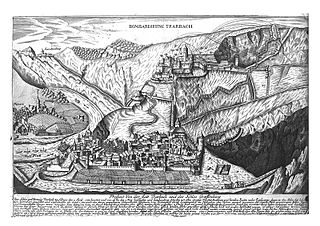 W
WThe Battle of Bitonto was a Spanish victory over Austrian forces near Bitonto in the Kingdom of Naples in the War of Polish Succession. The battle ended organized Austrian resistance outside a small number of fortresses in the kingdom.
 W
WThe Battle of Clausen was fought on 20 October 1735 near the town of Klausen, which was then in the Electorate of Trier and part of the Holy Roman Empire, and is now in the German state of Rhineland-Palatinate. French forces under the command of Marshal François de Franquetot de Coigny were defeated in an attempt to dislodge imperial troops under the command of Friedrich Heinrich von Seckendorff. The battle was one of the last significant engagements between the combatants in the War of the Polish Succession.
 W
WThe siege of Danzig of 1734 was the Russian encirclement and capture of the Polish city-port of Gdańsk, during the War of Polish Succession. It was the first time that troops of France and Russia had met as foes in the field.
 W
WThe Siege of Gaeta was a siege during the War of Polish Succession fought at Gaeta, Italy. The Habsburgs at Gaeta withstood four months of siege from the Bourbon armies under the Duke of Parma.
 W
WThe Battle of Guastalla or Battle of Luzzara was a battle fought on 19 September 1734 between Franco-Sardinian and Austrian (Habsburg) troops as part of the War of the Polish Succession.
 W
WThe Siege of Kehl was one of the opening moves of the French Rhineland campaign in the War of the Polish Succession, at the fortress town of Kehl in the upper Rhine River valley. A large French army under the command of the Duke of Berwick besieged and captured the fortress, which was lightly garrisoned and in poor condition.
 W
WThe Siege of Philippsburg was conducted by French forces against forces in the fortress of Philippsburg in the Rhine River valley during the War of the Polish Succession. The Duke of Berwick led 100,000 men up the Rhine Valley in opposition to Austrian forces, of which 60,000 were detached to invest the fortress at Philippsburg, beginning on 1 June 1734. A relief column of 35,000 under the aging Prince Eugene of Savoy was unsuccessful in actually relieving the siege. On 12 June Berwick was killed by a cannonball while inspecting the trenches, and command of the besiegers fell to Marshals d'Asfeld and Noailles. The fortress surrendered one month later, and the garrison withdrew to the fortress of Mainz with the honours of war.
 W
WThe Siege of Pizzighettone was the first major military engagement of the northern Italian campaigns of the War of the Polish Succession. Troops from France and the Kingdom of Sardinia began blockading the Habsburg Milanese fortress at Pizzighettone on 11 November 1733, commencing siege operations on 15 November. On 30 November the commander of the Austrian garrison negotiated a capitulation in which he promised to withdraw toward Mantua on 9 December if no relief arrived. As no reinforcements appeared by that time, the fortress' garrison withdrew with full honors on 9 December.
 W
WThe Siege of Trarbach was conducted during the War of the Polish Succession by French troops against a garrison of troops of the Holy Roman Empire in the fortress at Trarbach in the County of Sponheim, a small principality of the Holy Roman Empire. The French, led by Marshal Belle-Isle, were victorious, and destroyed the fortress.